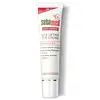What's inside
What's inside
 Key Ingredients
Key Ingredients

 Benefits
Benefits

 Concerns
Concerns

 Ingredients Side-by-side
Ingredients Side-by-side

Water
Skin ConditioningGlycerin
HumectantPrunus Amygdalus Dulcis Oil
Skin ConditioningPersea Gratissima Oil
Skin ConditioningPolyglyceryl-2 Dipolyhydroxystearate
Skin ConditioningButyrospermum Parkii Butter
Skin ConditioningC12-15 Alkyl Benzoate
AntimicrobialCetearyl Glucoside
EmulsifyingCetearyl Alcohol
EmollientPalmitoyl Tripeptide-1
Skin ConditioningPalmitoyl Tetrapeptide-7
Skin ConditioningUbiquinone
AntioxidantSodium Hyaluronate
HumectantBisabolol
MaskingSodium Lactate
BufferingCoco-Glucoside
CleansingPotassium Cetyl Phosphate
EmulsifyingCitric Acid
BufferingSodium Carbomer
Emulsion StabilisingButylene Glycol
HumectantSodium Hydroxide
BufferingParfum
MaskingBenzyl Alcohol
PerfumingPhenoxyethanol
PreservativeSodium Benzoate
MaskingWater, Glycerin, Prunus Amygdalus Dulcis Oil, Persea Gratissima Oil, Polyglyceryl-2 Dipolyhydroxystearate, Butyrospermum Parkii Butter, C12-15 Alkyl Benzoate, Cetearyl Glucoside, Cetearyl Alcohol, Palmitoyl Tripeptide-1, Palmitoyl Tetrapeptide-7, Ubiquinone, Sodium Hyaluronate, Bisabolol, Sodium Lactate, Coco-Glucoside, Potassium Cetyl Phosphate, Citric Acid, Sodium Carbomer, Butylene Glycol, Sodium Hydroxide, Parfum, Benzyl Alcohol, Phenoxyethanol, Sodium Benzoate
Caprylic/Capric/Succinic Triglyceride
EmollientCera Alba
EmollientIsoamyl P-Methoxycinnamate
UV AbsorberRicinus Communis Seed Oil
MaskingCaprylic/Capric Triglyceride
MaskingEthylhexyl Salicylate
UV AbsorberTocopheryl Acetate
AntioxidantC12-15 Alkyl Benzoate
AntimicrobialOryza Sativa Bran Wax
Skin ConditioningSimmondsia Chinensis Seed Oil
EmollientGlyceryl Ricinoleate
EmollientButyl Methoxydibenzoylmethane
UV AbsorberBisabolol
MaskingParfum
MaskingCaprylic/Capric/Succinic Triglyceride, Cera Alba, Isoamyl P-Methoxycinnamate, Ricinus Communis Seed Oil, Caprylic/Capric Triglyceride, Ethylhexyl Salicylate, Tocopheryl Acetate, C12-15 Alkyl Benzoate, Oryza Sativa Bran Wax, Simmondsia Chinensis Seed Oil, Glyceryl Ricinoleate, Butyl Methoxydibenzoylmethane, Bisabolol, Parfum
Ingredients Explained
These ingredients are found in both products.
Ingredients higher up in an ingredient list are typically present in a larger amount.
Bisabolol is famous for its skin soothing properties. It does this by blocking inflammatory signals, helping to reduce your body's reaction to irritation.
This ingredient also interferes with the process of hyperpigmentation. This can help with reducing dark spots and uneven tone.
Bisabolol is an antioxidant. Antioxidants help fight free-radicals. Free-radicals are molecules that may damage your skin cells. By fighting these free-radicals, Bisabolol may slow down signs of aging.
Studies have shown Bisabolol to have antimicrobial properties and may be a fungicide. These properties help preserve a product's shelf life.
All these properties makes bisabolol a great skin barrier helper ingredient.
Bisabolol also helps the absorption of other ingredients.
Note: Synthetic Bisabolol has been shown to be less effective.
Learn more about BisabololC12-15 Alkyl Benzoate is made up of Benzoic Acid and long chain alcohols. It has a low molecular weight.
C12-15 Alkyl Benzoate is an emollient and texture enhancer. Due to its solubility, it is often used in sunscreens to help evenly distribute active ingredients.
As an emollient, C12-15 Alkyl Benzoate helps soften and hydrate your skin. Emollients create a film on your skin that traps moisture within.
This ingredient has been reported to cause eye irritation.
Learn more about C12-15 Alkyl BenzoateParfum is a catch-all term for an ingredient or more that is used to give a scent to products.
Also called "fragrance", this ingredient can be a blend of hundreds of chemicals or plant oils. This means every product with "fragrance" or "parfum" in the ingredients list is a different mixture.
For instance, Habanolide is a proprietary trade name for a specific aroma chemical. When used as a fragrance ingredient in cosmetics, most aroma chemicals fall under the broad labeling category of “FRAGRANCE” or “PARFUM” according to EU and US regulations.
The term 'parfum' or 'fragrance' is not regulated in many countries. In many cases, it is up to the brand to define this term.
For instance, many brands choose to label themselves as "fragrance-free" because they are not using synthetic fragrances. However, their products may still contain ingredients such as essential oils that are considered a fragrance by INCI standards.
One example is Calendula flower extract. Calendula is an essential oil that still imparts a scent or 'fragrance'.
Depending on the blend, the ingredients in the mixture can cause allergies and sensitivities on the skin. Some ingredients that are known EU allergens include linalool and citronellol.
Parfum can also be used to mask or cover an unpleasant scent.
The bottom line is: not all fragrances/parfum/ingredients are created equally. If you are worried about fragrances, we recommend taking a closer look at an ingredient. And of course, we always recommend speaking with a professional.
Learn more about Parfum